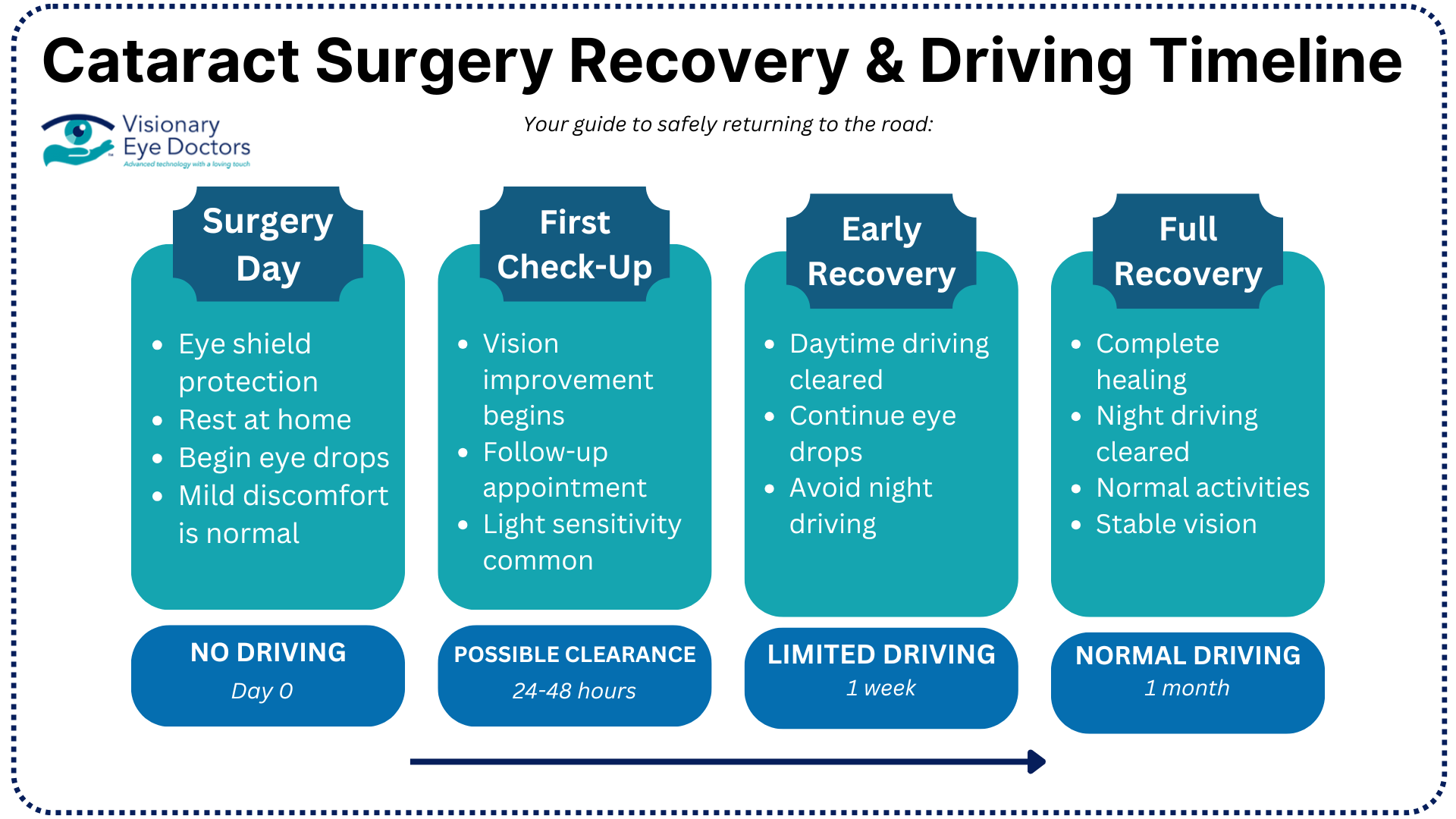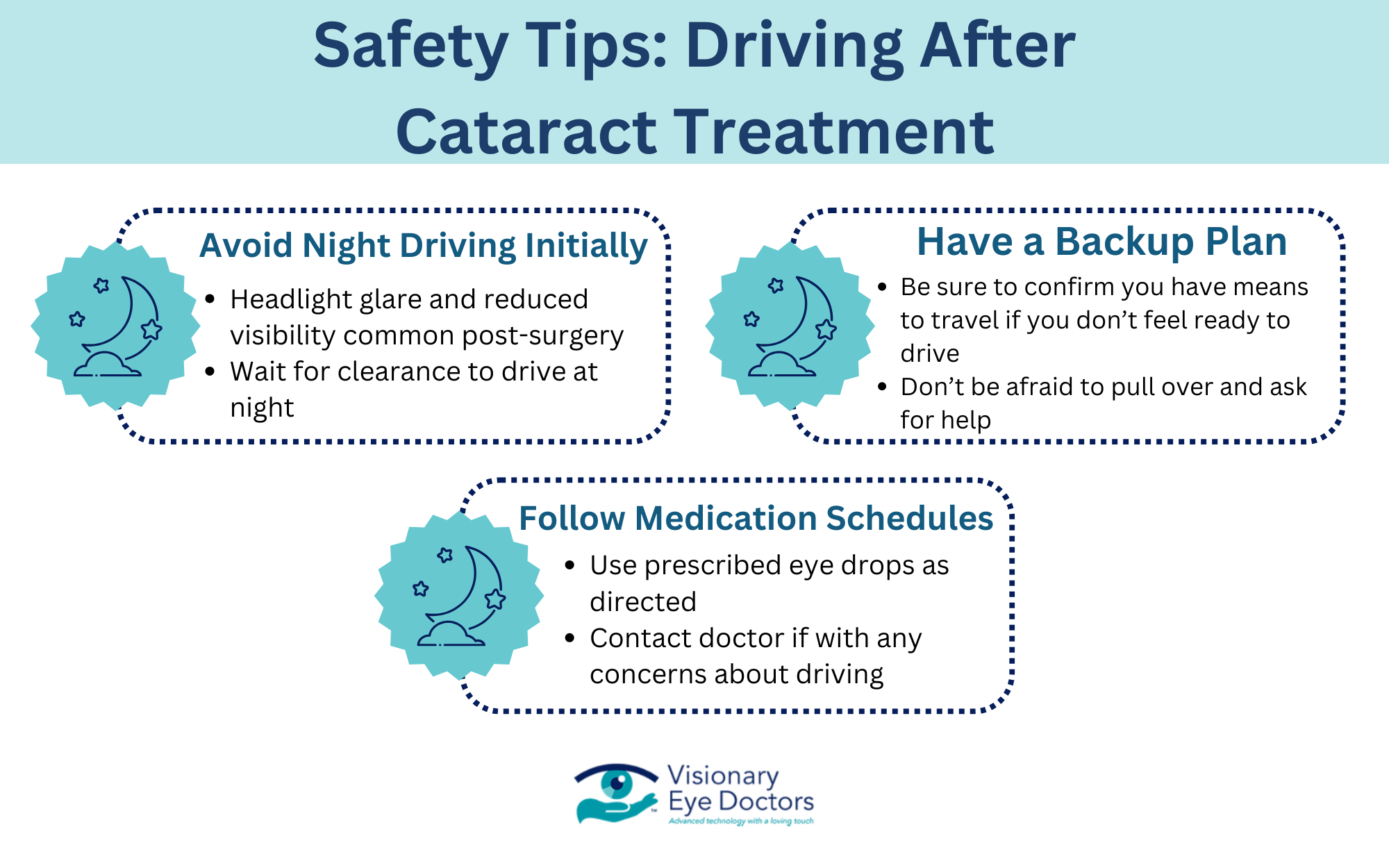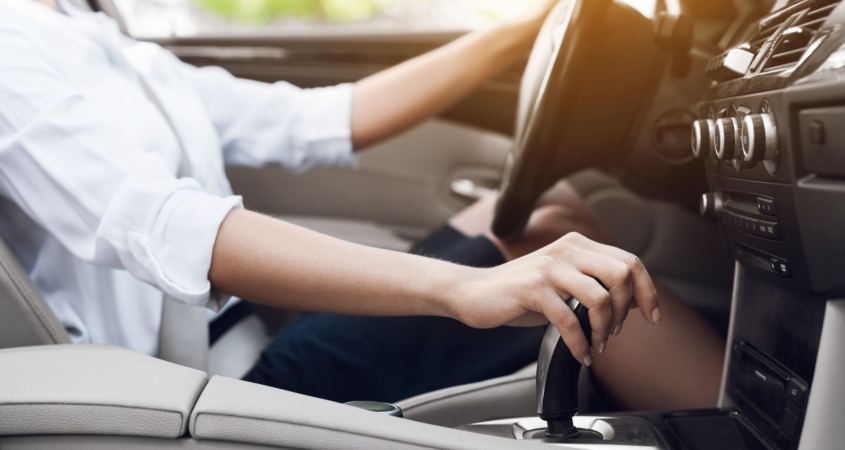How Long After Cataract Surgery Can You Drive?
The Quick Answer: Most patients can return to driving within 24-48 hours after cataract surgery, but this timeline varies based on individual healing and your eye doctor’s clearance. The key is ensuring your vision meets safe driving standards before getting behind the wheel.
Cataract surgery is one of the most successful and commonly performed procedures worldwide, involving the removal of the eye’s cloudy natural lens and replacement with a clear artificial lens. This safe procedure offers remarkable improvements in visual clarity that can dramatically enhance your daily life.
While there is a 1-2 day general timeframe, there’s more to consider for safe driving after your cataract operation. From understanding how your vision changes during recovery to knowing the warning signs that suggest you should wait longer, this guide covers everything you need to know about returning to normal activities like driving after cataract surgery.
What Happens to Your Vision Right After Cataract Surgery
The first 24-48 hours after your cataract removal are crucial for understanding when you’ll be ready to drive again. During this immediate recovery period, your eye is adjusting to the new artificial lens that replaced your cloudy lens.
Most patients experience some degree of blurred vision immediately following the procedure. This is completely normal as part of the healing process. Your eye surgeon will provide you with an eye shield to protect your eye during the first day, and you’ll need to use prescribed eye drops to prevent infection and support recovery.
Common vision changes you might notice include:
- Light sensitivity, especially when moving between indoor and outdoor environments
- Temporary blurriness as your eye adjusts to the new lens
- Mild discomfort or a gritty feeling in the treated eye
- Slight changes in depth perception as your brain adapts to improved visual clarity
The good news is that vision improvement often begins within hours of this routine procedure. Many patients notice clearer vision by the day after surgery, though complete stabilization of their new lens can take several weeks. During your recovery time, it’s important to avoid strenuous activity, heavy lifting, and activities that could put pressure on your healing eye.
Your vision may fluctuate during the first few days, which is why your eye doctor needs to evaluate your visual clarity before clearing you to drive. This isn’t just about being able to see clearly—it’s about ensuring your depth perception, peripheral vision, and ability to judge distances have returned to safe levels for operating a vehicle.

Factors That Affect When You Can Drive Again
Several factors influence your recovery period and determine when it’s safe to return to driving after cataract surgery. Understanding these variables helps set realistic expectations for your timeline.
Type of Surgery Performed
- Both traditional and laser cataract surgery have similar recovery timelines for driving
- Most patients can resume driving within 1-3 days after either procedure, once vision stabilizes
- Your doctor will clear you for driving at your follow-up appointment based on your healing
Which Eye Was Treated
- Surgery on your dominant eye may cause more noticeable vision changes initially
- Non-dominant eye surgery is often easier to adjust to, and therefore often patients can often drive sooner than with dominant eye surgery.
Your Pre-Surgery Vision
- If you previously had severe vision loss, while you will experience dramatic improvements, you may need more adjustment time before driving.
- Less severe cataracts adapt more quickly to driving
Type of Intraocular Lens
- Your artificial lens choice affects visual recovery, but you should always consult your doctor before driving
- Standard monofocal lenses: Most patients can resume driving within 1-3 days once vision stabilizes
- Toric and multifocal lenses: Similar 1-3 day timeline, though night driving may take longer to adjust to
- Light Adjustable Lens: May take 1-2 weeks, as you’ll need light treatments to customize the lens before final vision is achieved
Individual Healing Factors
Everyone’s healing process is unique, with factors like age, overall health, and how well you follow post-surgery instructions all influencing your recovery time. While some patients feel comfortable driving within 24 hours of surgery, others may need several days before their vision stabilizes enough for safe driving.

Signs You’re Ready to Drive Safely
Before resuming driving, your eye doctor will evaluate certain visual criteria during your follow-up appointment. Understanding these criteria helps you recognize when you’re ready to drive as well.
Visual Clarity Standards
- Read road signs clearly at appropriate distances
- See traffic lights and their colors distinctly
- Spot pedestrians, cyclists, and other vehicles
- You might need new prescription glasses, depending on your chosen lens type
Depth Perception Recovery
- Judge distances between vehicles accurately
- Determine how far objects are when parking or changing lanes
- Gauge the speed of approaching traffic
- Typically returns within the first few days as your brain adjusts
Light Sensitivity Management
- You may experience increased light sensitivity initially
- Drive comfortably in normal daylight without excessive squinting
- Sunglasses help during the first few weeks of recovery
Peripheral Vision Comfort
- Side vision should feel natural and unobstructed
- Any double vision or visual disturbances should resolve before driving
- These issues are rare but can occur during early recovery
Safety Tips for Your First Time Driving After Surgery
When your eye doctor clears you to drive, starting gradually helps ensure a safe transition back to normal activities.

Avoid Night Driving Initially
Even though your vision may be excellent during the day, night driving presents additional challenges during early recovery. Headlight glare and reduced visibility can be more problematic in the weeks following surgery. Wait until your eye doctor specifically clears you for night driving.
Have a Backup Plan
For your first few driving attempts, make sure someone drives with you or can pick you up if you feel uncomfortable or notice any vision problems while driving. Keep your eye doctor’s contact information handy and don’t hesitate to pull over if anything feels wrong with your vision.
Follow Medication Schedules
Continue using your prescribed eye drops as directed, even when you resume driving. These medications are crucial for preventing infection and supporting the healing process. Some drops can temporarily blur your vision, so time their use appropriately around driving.
When to Contact Your Eye Doctor
Certain warning signs indicate you should delay driving and contact your cataract surgeon immediately. Being aware of these symptoms helps prevent serious complications and ensures your safety on the road.
Vision Problems That Require Immediate Attention
Contact your eye doctor if you experience:
- Sudden vision loss
- Severe eye pain that doesn’t improve with prescribed medications
- Persistent double vision
- Significant increase in floaters or flashing lights
Signs Your Recovery Isn’t Progressing Normally
Contact your eye doctor if:
- Your vision isn’t improving after several days
- You continue experiencing severe light sensitivity beyond the first week
- You have discharge or excessive tearing that seems infected
These issues need professional evaluation before you resume driving.
Questions for Your Follow-up Appointment
During your scheduled follow-up appointments, ask specific questions about driving:
- Whether you need new glasses or contact lenses for optimal driving vision
- When you can return to all normal activities without restrictions
Remember that this information is for informational purposes only and shouldn’t replace professional medical advice. Your eye doctor knows your specific situation and healing progress, making their clearance essential before you resume driving.

Expert Cataract Care at Visionary Eye Doctors
Choosing an experienced cataract surgeon significantly impacts your recovery time and outcomes, including how quickly you can safely return to driving. At Visionary Eye Doctors, our skilled eye surgeons use advanced techniques and technology to ensure optimal results from your cataract surgery.
Our comprehensive approach includes detailed pre-operative planning to choose the best intraocular lens for your lifestyle and vision goals, precise surgical techniques that minimize recovery time, and thorough post-operative care with clear instructions for activities like driving. We provide personalized guidance throughout your recovery process, ensuring you feel confident and safe when you resume normal activities.
Whether you’re considering traditional or laser cataract surgery, our experienced surgeons will help you understand your options and what to expect during recovery. The procedure has helped countless patients not only remove their cataracts but also reduce their dependence on glasses for activities like driving.
Ready to learn more about cataract surgery and how it can improve your driving vision? Contact Visionary Eye Doctors today to schedule a consultation and discover how our expertise can help you see the road ahead more clearly than ever.



